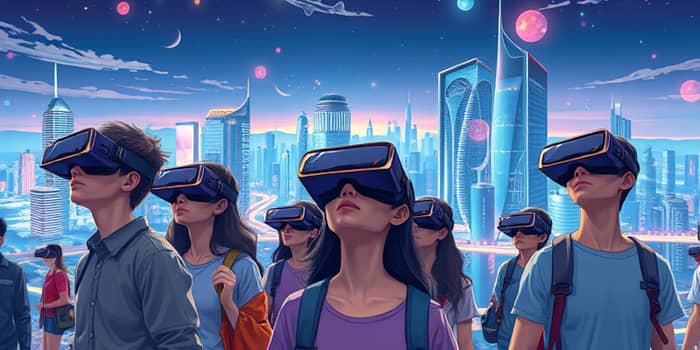The promise of the metaverse is reshaping how we socialize, work, and do business. As immersive worlds become more accessible, understanding their economic effects becomes vital.
Definition & Core Principles
The metaverse is more than a buzzword; it is a persistent, shared digital universe where users interact through avatars, transactions flow seamlessly, and experiences are rendered in real time. Coined by Neal Stephenson in his novel Snow Crash (1992), the term combines “meta” and “universe” to describe a network of interconnected virtual spaces.
Key features include:
- Immersion and real-time interactivity across VR, AR, and mixed reality.
- User agency and identity continuity from one experience to another.
- Interoperability across platforms, devices, and digital assets.
- Data portability and seamless payment systems.
Market Size & Growth Projections
Recent reports indicate exponential expansion in the metaverse market. Projections range widely, but consensus points to a multi-trillion-dollar arena by 2030. North America leads with a 40–70% market share, followed by rapid growth in Asia Pacific and Europe.
Consider this snapshot of industry forecasts:
Experts estimate the metaverse could add $5 trillion to global GDP by 2030, driven by digital goods, virtual real estate, and immersive services.
Technology Stack & Infrastructure
At its core, the metaverse relies on a complex technology ecosystem:
- Immersive hardware: headsets, haptic suits, spatial trackers.
- Software platforms: Unity, Unreal Engine, Roblox, Horizon Worlds.
- Cloud computing and 5G networks for persistent, scalable environments.
- AI-driven interactivity and personalization across experiences.
- Blockchain and NFTs for secure digital ownership and decentralized finance.
These components combine to form persistent 3D worlds where assets, identities, and transactions maintain continuity.
Industry Segmentation & Key Applications
The metaverse touches nearly every sector. Major applications include:
- Gaming: Virtual tournaments, social hubs, digital asset marketplaces.
- Social Networking: Shared event spaces and live performances.
- Remote Work & Collaboration: Virtual offices, interactive whiteboards.
- Education & Training: Simulated labs, virtual classrooms, skill workshops.
- Healthcare: Telemedicine, therapy sessions in immersive environments.
- Retail & E-commerce: Digital storefronts, try-before-you-buy experiences.
- Finance: DeFi platforms, NFT auctions, crypto banking in VR lobbies.
- Real Estate: Virtual property development, land parcel trading.
Economic Implications
The metaverse drives value creation through digital goods, services, and experiences. McKinsey projects up to $5 trillion in value by 2030, encompassing:
- Virtual real estate transactions valued in the billions of dollars.
- Digital fashion, accessories, and avatar enhancements forming new consumer markets.
- Enterprise solutions like digital twins and supply chain simulations reducing costs.
Gaming benefits substantially, as 60% of players engage beyond gameplay for socializing and commerce. Retailers see a surge in personalized, interactive shopping, while enterprises adopt virtual workspaces to boost productivity.
Challenges & Risks
Despite its promise, the metaverse faces hurdles:
- Interoperability gaps due to proprietary ecosystems and lack of universal standards.
- Privacy and security concerns, with potential for data breaches and identity theft.
- Regulatory ambiguity around digital property rights, taxation, and user safety.
- High hardware costs limiting widespread adoption and raising digital inequality.
- Low awareness: 31% of U.S. adults remain unfamiliar with the concept.
Addressing these risks requires collaboration between tech companies, policymakers, and standards bodies.
Future Outlook & Expert Opinions
Sixty-eight percent of technology experts predict sharp growth in the next five years. Innovations in AI, spatial computing, and network infrastructure will drive user adoption and enable new business models. The enterprise metaverse—virtual business environments, digital twins, and supply chain management—emerges as a critical frontier beyond gaming and social use.
Major investors like Meta, Microsoft, Nvidia, Apple, Google, and Epic Games are deploying billions in research, platforms, and infrastructure. Venture capital continues to fuel startups focusing on XR hardware, immersive software, and blockchain solutions.
Regional Insights & Conclusion
North America leads adoption, but Asia Pacific shows rapid uptake through gaming and e-commerce. Europe emphasizes regulation and enterprise use cases, while other regions vary with infrastructure readiness and policy frameworks.
The metaverse represents an unprecedented opportunity to reshape economies and societies. Its success depends on tackling interoperability, security, and inclusion challenges. As immersive worlds evolve, stakeholders must embrace collaborative standards, robust regulatory frameworks, and investments in accessible hardware and network infrastructure.
By understanding the economic implications and driving technologies, businesses and policymakers can harness the metaverse’s potential to create new markets, enhance productivity, and enrich human experiences.
References
- https://www.techtarget.com/whatis/feature/The-metaverse-explained-Everything-you-need-to-know
- https://www.fortunebusinessinsights.com/metaverse-market-106574
- https://en.wikipedia.org/wiki/Metaverse
- https://www.researchnester.com/reports/metaverse-market/3925
- https://chain.link/education/metaverse
- https://market.us/report/metaverse-market/
- https://www.youtube.com/watch?v=U8HQ5ihX9cE
- https://www.grandviewresearch.com/industry-analysis/metaverse-market-report
- https://www.mckinsey.com/featured-insights/mckinsey-explainers/what-is-the-metaverse
- https://www.polarismarketresearch.com/industry-analysis/metaverse-market
- https://www.meta.com/metaverse/what-is-the-metaverse/
- https://www.emergenresearch.com/industry-report/metaverse-market
- https://www.strategicmarketresearch.com/market-report/metaverse-market
- https://www.einnews.com/pr_news/864875129/metaverse-market-to-hit-1-237-billion-by-2030-driven-by-vr-ar-digital-innovation-boom
- https://www.mckinsey.com/capabilities/growth-marketing-and-sales/our-insights/value-creation-in-the-metaverse










